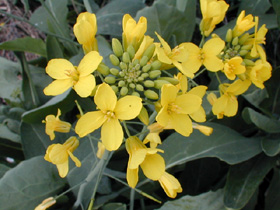INDIAN MUSTARD
|
 |
| File Size: 70 KB |
|
|
|
Brassica juncea (L. ) Czern.
|
| Cowley County, Kansas |
| Annual |
| Height: 1 - 3 feet |
| Family: Brassicaceae - Mustard Family |
| Flowering Period: May, June, July, August, September,October |
|
| Stems: | | Erect, simple or branched above, glabrous, glaucous. | | Leaves: | | Alternate, simple, glabrous, glaucous; basal leaves 4 to 8 inches long, deeply lobed, on stalks; margins with coarse or rounded teeth directed outward; upper leaves progressively smaller, lanceolate to oblong, sessile or on short stalks; margins with short teeth or entire. | | Inflorescences: | | Racemes, long, terminal, on slender, spreading stalks. | | Flowers: | | Yellow, about .5 inch across; petals 4, sepals 4. | | Fruits: | | Pod, long, narrow, 1 to 3 inches long, several-seeded, ascending or spreading, prominent nerve on each valve, beak conical, less than one quarter length of body. | | Habitat: | | Waste areas, roadsides, gardens, and cultivated fields. | | Distribution: | | Principally in the east half of Kansas. | | Origin: | | This weedy species is a native of eastern Europe and western Asia. | | Toxicity: | | The seeds can be toxic to livestock. | | Forage Value: | | Deer will consume the foilage. | | Uses: | | Early pioneers are said to have eaten the young shoots after boiling them. | | | | See Brassica kaber , a related species. |
|
| Indian mustard |  | | 140 KB | | Cowley County, Kansas |
| | Indian mustard |  | | 77 KB | | Cowley County, Kansas |
| | Indian mustard leaf |  | | 73 KB | | Cowley County, Kansas |
| | Indian mustard silique |  | | 48 KB | | Cowley County, Kansas |
| |
|
|
|
|
|
|